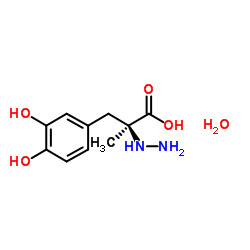Carbidopa monohydrate

Carbidopa monohydrate structure
|
Common Name | Carbidopa monohydrate | ||
|---|---|---|---|---|
| CAS Number | 38821-49-7 | Molecular Weight | 244.244 | |
| Density | 1.42 g/cm3 | Boiling Point | 528.7ºC at 760 mmHg | |
| Molecular Formula | C10H16N2O5 | Melting Point | N/A | |
| MSDS | Chinese USA | Flash Point | 273.5ºC | |
| Symbol |

GHS07 |
Signal Word | Warning | |
|
[(11)C]5-HTP and microPET are not suitable for pharmacodynamic studies in the rodent brain.
J. Cereb. Blood Flow Metab. 34(1) , 118-25, (2014) The PET tracer [(11)C]5-hydroxytryptophan ([(11)C]5-HTP), which is converted to [(11)C]5-hydroxytryptamine ([(11)C]5-HT) by aromatic amino acid decarboxylase (AADC), is thought to measure 5-HT synthesis rates. But can we measure these synthesis rates by kinet... |
|
|
Pharmacokinetic evaluation of formulated levodopa methyl ester nasal delivery systems.
Eur. J. Drug Metab. Pharmacokinet. 39(4) , 237-42, (2014) The objective of this study was to investigate the pharmacokinetic characteristics of levodopa (L-dopa) from nasal powder formulations using highly water-soluble levodopa methyl ester hydrochloride (LDME). In vivo pharmacokinetic studies were carried out with... |
|
|
Therapeutic targeting of BRCA1-mutated breast cancers with agents that activate DNA repair.
Cancer Res. 74(21) , 6205-15, (2014) Cancers due to germline mutations in the BRCA1 gene tend to lack targets for approved chemoprevention agents. This study aimed at a targeted chemoprevention strategy for BRCA1-associated malignancies. Mutant BRCA1 limits the base-excision DNA repair activity ... |
|
|
[Scleroderma-like syndrome with bullous morphea during treatment with 5-hydroxytryptophan, carbidopa and flunitrazepam].
Ann. Dermatol. Venereol. 119(3) , 209-11, (1992)
|
|
|
Beneficial effects of natural phenolics on levodopa methylation and oxidative neurodegeneration.
Brain Res. 1497 , 1-14, (2013) Levodopa (L-DOPA) is widely used for symptomatic management in Parkinson's disease. We recently showed that (-)-epigallocatechin-3-gallate, a tea polyphenol, not only inhibits L-DOPA methylation, but also protects against oxidative hippocampal neurodegenerati... |
|
|
Three cases of impulse control disorder in Parkinson's disease patients receiving dopamine replacement therapy.
Ir. Med. J. 106(1) , 24-5, (2013) Impulse control disorders (ICDs) are a known side effect of dopamine replacement therapy in patients with Parkinson's disease (PD). They can have devastating consequences for patients and their families. |
|
|
A new quantitative rating scale for dyskinesia in nonhuman primates.
Behav. Pharmacol. 26(1-2) , 109-16, (2014) The aim of this study was to develop a quantitative scale to assess levodopa-induced dyskinesias (LIDs) in nonhuman primates using a video-based scoring system [Quantitative Dyskinesia Scale (QDS)]. Six macaques with stable Parkinsonism and LID were used for ... |
|
|
Synthesis of ZnO nanorods and their application in the construction of a nanostructure-based electrochemical sensor for determination of levodopa in the presence of carbidopa.
Analyst 139(17) , 4356-64, (2014) A novel carbon paste electrode modified with ZnO nanorods and 5-(4'-amino-3'-hydroxy-biphenyl-4-yl)-acrylic acid (3,4'-AAZCPE) was fabricated. The electrochemical study of the modified electrode, as well as its efficiency for the electrocatalytic oxidation of... |
|
|
Ropinirole does not affect plasma arginine vasopressin levels in patients with advanced Parkinson's disease.
Neuro Endocrinol. Lett. 33(7) , 680-3, (2012) Several cases of syndrome of inappropriate antidiuresis induced by anti-Parkinson agents have been reported. Our previous study demonstrated that pergolide and pramipexole stimulated elevation of plasma arginine vasopressin (AVP) levels in some patients with ... |
|
|
Parkinson disease treatment in hospitals and nursing facilities: avoiding pitfalls.
Mayo Clin. Proc. 89(7) , 997-1003, (2014) The unique needs of patients with Parkinson disease challenge staff when such patients are admitted to hospitals or nursing facilities. Prolongation of the hospital stay, falls with injuries, fainting, or declining motor function may result from therapeutic m... |